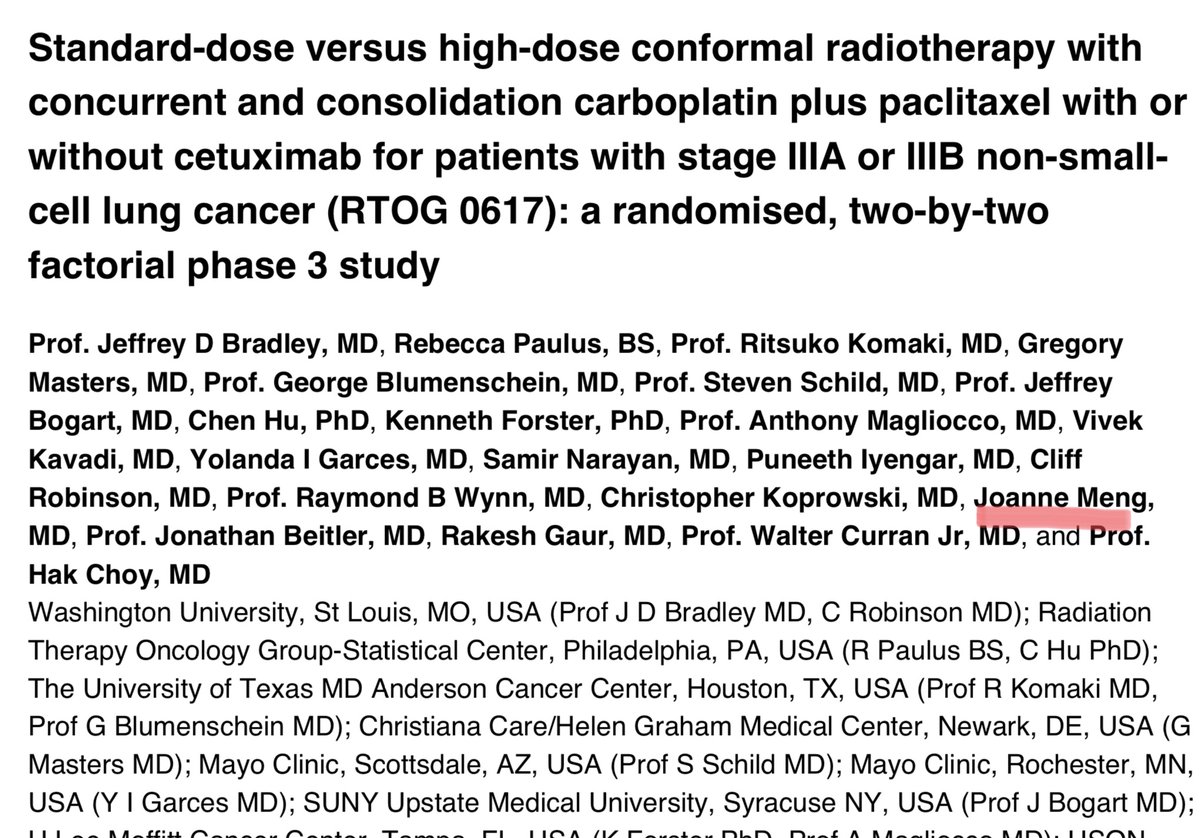
9 November: RTOG 0617 & Interim Analysis
For Lung Cancer Awareness Month #LCAM I’m going to summarize 30 important lung cancer trials over 30 days. These posts are directed at non-medical professionals, with descriptions of the results and of what makes a good trial.#lcsm 1/15
For Lung Cancer Awareness Month #LCAM I’m going to summarize 30 important lung cancer trials over 30 days. These posts are directed at non-medical professionals, with descriptions of the results and of what makes a good trial.#lcsm 1/15

Today we have another trial in locally advanced lung cancer. By the time of this trial (2006) the established standard treatment was a radiation dose of 60 Gy plus concurrent chemotherapy. This trial looked at higher radiation doses, and at the new drug, cetuximab. 2/15
Patients were randomized twice: to either 60 or 74 Gy, and to either receive cetuximab or not. This created four arms (60 or 74 Gy, each with or without cetuximab). The cetuximab didn’t add anything, and I’m not going to focus on it in our discussion. 3/15
The dose 60 Gy had been established in the 1970s. As radiation techniques improved it became feasible to give higher doses. Non-randomized studies of up to 74 Gy showed promising results. We shall have occasion this month to revisit the topic of promising non-randomized studies.
The trial was intended to enroll over 500 patients, but randomization to 74 Gy was stopped early (after 419 people) because an interim analysis showed that the 74 Gy arm could not be superior to 60 Gy (called “crossing the futility boundary” see below). 5/15
Indeed, people in the 74 Gy arm had significantly worse survival than those in the 60 Gy arm (20.3 months vs 28.7 p=0.0042). 6/15 

This was a surprising result, and considerable subsequent work suggested that increased mortality in the 74 Gy group was driven by the dose of radiation given to the heart while treating the lung cancer. This realization has improved the safety of radiation delivery today. 7/15
Another interesting point is how well people did in this trial compared to prior. Recall our discussion of 4 November; in the early days of chemo/rads for stage III, patients had a median survival of 13.7 months. In this trial the 60 Gy arm had median survival of 28.7 months.8/15
This improvement in survival over time is probably attributable to:
1. PET scans, which identify many patients who actually have stage IV cancer
2. Improved radiation technique
3. Optimized chemotherapy scheduling (concurrent rather than sequential) 9/15
1. PET scans, which identify many patients who actually have stage IV cancer
2. Improved radiation technique
3. Optimized chemotherapy scheduling (concurrent rather than sequential) 9/15
Let’s talk about interim analysis. Studies will often schedule review of the results as the trial is ongoing to see whether one arm is obviously superior. If so the trial should stop early, because it would no longer be ethical to randomize people to the arm known to be inferior.
This study planned three interim analyses, meaning they were planning to compare the arms four times (including the final analysis). Recall we previously said that to call a study positive we want a less than 5% chance of a false positive (p<0.05 on the primary endpoint). 11/15 

If a study were to do a test and accept p up to 0.05 for each of the four analyses then the likelihood of erroneously declaring the study positive would be greater than 5%. For this reason, interim analyses require more stringent p-values. 12/15
For instance, a study might be designed to stop:
After first look if p<0.0001
After second look if p<0.004
After third look if p<0.019
Positive after final look if p<0.043
The cumulative likelihood of a false positive result from all of these is 5%. 13/15
After first look if p<0.0001
After second look if p<0.004
After third look if p<0.019
Positive after final look if p<0.043
The cumulative likelihood of a false positive result from all of these is 5%. 13/15
Although not the result the investigators hoped for, this trial contributed knowledge and made radiotherapy safer.
The interim analyses are an example of a safety feature built into trials to minimize the number of people exposed to inferior treatment arms. 14/15
The interim analyses are an example of a safety feature built into trials to minimize the number of people exposed to inferior treatment arms. 14/15
h/t to @finn_corrine for suggesting this study.
See you tomorrow when we’ll discuss our first study in small cell lung cancer, and try to convert you into understanding the concept of a confidence interval.
15/15
See you tomorrow when we’ll discuss our first study in small cell lung cancer, and try to convert you into understanding the concept of a confidence interval.
15/15

• • •
Missing some Tweet in this thread? You can try to
force a refresh










